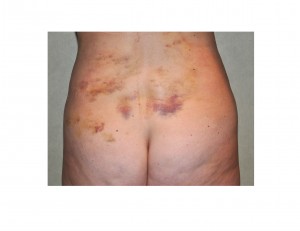Liposuction is a cosmetic procedure that is both common and effective, characteristics that many cosmetic operations share. But one unique feature of liposuction is the degree of tissue trauma that it creates. Despite the many glitzy advertisements for the procedure and countless impressive before and after photographs available on the internet, fat removal by aspiration involves substantial recovery. To reach the result that one aspires to is a process and not merely a weekend or week long effort.
The tissue trauma from liposuction disrupts blood and lymphatic vessels as well as the fact cells themselves. While liposuction cannulas are blunt-tipped, they still cause bleeding and this accounts for the bruising that one sees. The blood and fatty material that is released results in an inflammatory response which creates swelling. The persistence of swelling after liposuction is due to the disruption of the local lymphatic system which is very slow to clear the tissue debris and retained fluids.
While this is a good biologic explanation of what happens to body areas that receive liposuction, what does that actually mean to a patient? The actual translation of this biologic response to what a patient will see during their recoveris exactly what results in a lot of common questions and concerns after the procedure. To illustrate these points let’s look at the body’s response to liposuction in the most frequently treated area, the abdomen and flanks.
Be prepared to see swelling and bruising through the entire abdomen during the first week or two after surgery. It is a good sign if you already look thinner or less full in the first week after surgery but don’t let it alarm you if you don’t. Some patients will look bigger than before, weigh more and their pants are tighter or even can’t be buttoned or snapped together. This is all thanks to fluid retention and resultant swelling.


One may be tempted to think that certain types of liposuction may avoid this degree of swelling and bruising…but this is not so. No matter what energy is applied to the fat (laser, ultrasonic etc), the degree of tissue trauma is not significantly different…and neither is the recovery. One should expect to see much of the bruising and swelling to eventually clear by three weeks after surgery and up to three months to see the final contour in all of its detail.
Dr. Barry Eppley
Indianapolis, Indiana


